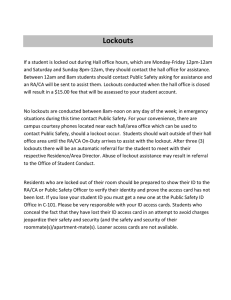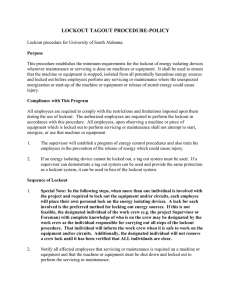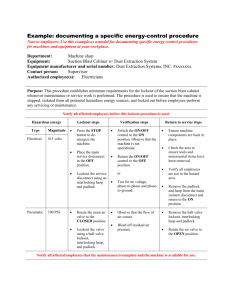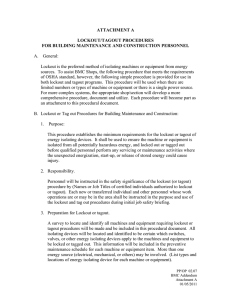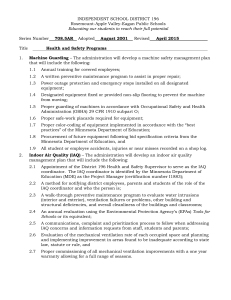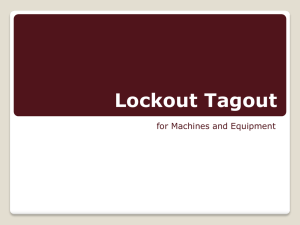for Machines and Equipment
advertisement
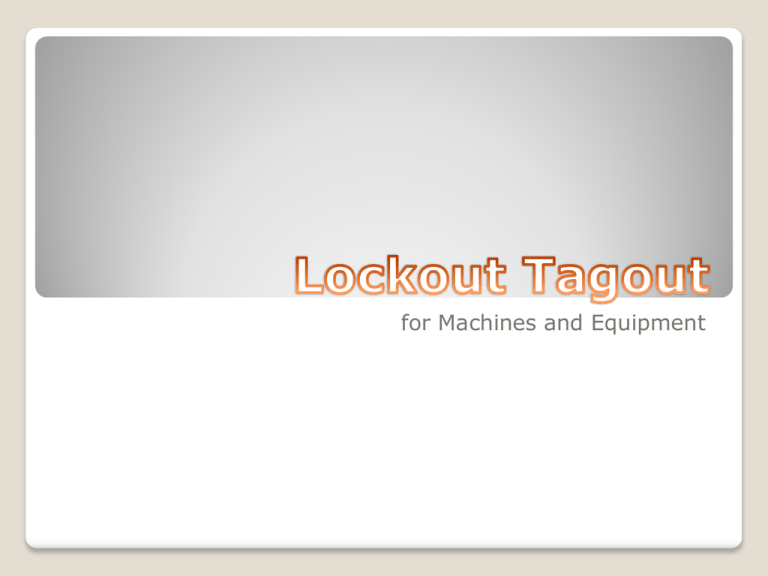
for Machines and Equipment http://www.cdc.gov/niosh/docs/99-110/ In 20 states, over the course of 15 years, NIOSH recorded 152 fatalities that could have been prevented had lockout tagout procedures been followed. -andThere were 171 fatal workplace amputations and nearly 88,500 nonfatal workplace amputations reported during the period 1992-99. http://www.bls.gov/opub/cwc/sh20030114ar01p1.htm Deenergization of machines combined with the use of specified locks and tags to protect individuals who are performing maintenance and/or service work. Note: lockout tagout needs to be used when servicing or maintaining power tools, equipment, machines, etc. however this presentation only refers to machines in order to minimize text. A worker who is replacing a power transmission belt could be injured while performing their work if: 1. The machine is inadvertently started; or 2. Stored energy is accidentally released. To prevent an accident, residual energy is eliminated and the source of energy is locked out before the work is performed. Changing a saw blade Working on or near exposed energized electrical parts Lockout tagout is only intended to protect individuals performing work from others who may inadvertently start-up machinery or otherwise release stored energy Of the 152 fatalities previously mentioned, 88% were caused by the individual performing the maintenance or service work. Only a small percentage of the accidents were caused by others who released stored energy or started-up a machine another was servicing or maintaining. Point of emphasis - follow proper lockout tagout procedures even if no one else is around to cause an accident when you are servicing or maintaining machinery or equipment. Some lockout tagout procedures have been developed for machines in the college. These procedures are portrayed on labels attached to the machines. Contact the college Health & Safety Officer (4226589) to have a label affixed to a machine Appropriate lockout procedures are dependant upon the machine and potential hazards. Other Procedures? Note: see the next two slides to review established procedures. 1. Unplug the machine 2. Try to start the machine Note: it shouldn’t start, if it does then develop your own procedures specific to the machine. 3. Maintain control of the machine throughout the work by: A. Applying a lockout device and lock to the plug end and maintaining control of the key; -orB. Not leaving the machine while it is being serviced or maintained and keeping the plug-end in sight throughout the work. Example: A bench grinder that is plugged in a. Lockout Procedures: 1. 2. 3. 4. Flip the cutoff switch or circuit breaker to open the circuit and isolate the energy source. Lockout the energy source (using an authorized lock bearing your ID) Tag the lock to notify individuals that you are working on the machine. Try to start up the machine (Note: if the machine starts up then these procedures aren’t appropriate) b. Perform the service or maintenance work. c. Restore to Service: 1. 2. Remove tools and replace guards. Remove the lockout device & reenergize the machine. Example: A table saw that is hard wired. Some machines can’t be adequately locked out using the procedures already mentioned on the previous two slides therefore specific lockout tagout procedures must be developed. These procedures must include the 13 steps detailed in the next slide. Contact the college Health & Safety Officer (422-6589) for help developing lockout tagout procedures. (Tags are attached to locks to identify who locked the machine out.) Thirteen Steps 1. 2. 3. 4. 5. 6. 7. 8. 9. 10. 11. 12. 13. Notify all affected individuals of the servicing / maintenance work and that the equipment or machine will be shut-down and locked out Review specific lockout procedure Stop the equipment / machine Isolate the energy Lockout the hazardous energy Dissipate any stored energy Attempt to restart the equipment / machine Perform the work Check machine prior to restoring it to service to ensure that nonessential items have been removed and that the machine or equipment components are operationally intact Check the work are to ensure all individuals are safely positioned Verify that all controls are in the neutral position Remove lockout devices and reenergize the equipment / machine Note: the removal of some blocking may require reenergization of the machine before safe removal. Notify affected individuals that the servicing or maintenance is completed. In the college, lockout tagout devices should be colored red and identified as lockout devices. Lockout devices are only to be removed by the individual who installed the device(s). (Don’t use lockout devices for purposes other than for lockout tagout.)
